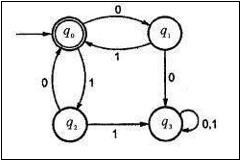
 Data Structure
Data Structure Networking
Networking RDBMS
RDBMS Operating System
Operating System Java
Java MS Excel
MS Excel iOS
iOS HTML
HTML CSS
CSS Android
Android Python
Python C Programming
C Programming C++
C++ C#
C# MongoDB
MongoDB MySQL
MySQL Javascript
Javascript PHP
PHP
- Selected Reading
- UPSC IAS Exams Notes
- Developer's Best Practices
- Questions and Answers
- Effective Resume Writing
- HR Interview Questions
- Computer Glossary
- Who is Who
Construct RE for given finite automata with Arden’s theorem
There are two methods for converting a Deterministic Finite Automata (DFA) to Regular expression (RE). These methods are as follows −
- Arden's Theorem Method.
- State Elimination Method.
Let us understand the Arden's Theorem method in detail.
Arden's Theorem
Let P and Q be the two regular expressions.
If P does not contain null string, then the following equation in R, viz R = Q + RP,
Which has a unique solution by R = QP*
Here,
- The finite automata (FA) does not have epsilon moves.
- It must have only initial state q1.
- Its states are q1, q2, q3,....qn. The final state may be some qi where i<=n.
- qi is the regular expression representing a set of strings accepted by the finite automata even though qi is a final state.
Now let us consider a problem, that how to construct given finite automata with the help of Arden's theorem.
Problem
Find out the regular expression for the given finite automata by applying Arden's theorem.

Solution
Let us see the equations.
q0 = q1 + q20+ E
q1 =q00
q2 =q01
q3 = q10 + q21+ q3(0+1)
Let us solve q0 first, as shown below−
q0 = q1 + q20+ E
q0 = q1 + q010+ E
q0 = q0(01 +10)+ E
q0 = E(01+10)*
q0 = (01+10)*
·: R = Q+ RP
=> QP* where
R =q0 ,Q =e, P= (01 + 10)
Thus, the regular expression will be as follows −
r = {01+10)*
Since q0 is a final state, we are interested in q0 only.

